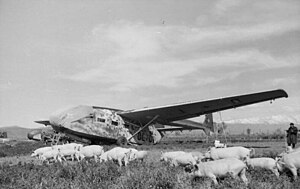Gotha Go 242
| Gotha Go 242 | |
|---|---|
 |
|
| Gotha Go 242 in Grosseto, 1943 | |
| Role | Transport glider |
| Manufacturer | Gothaer Waggonfabrik |
| Designer | Albert Kalkert |
| First flight | 1941 |
| Introduction | 1941 |
| Primary user | Luftwaffe |
| Number built | 1,528 |
The Gotha Go 242 was a transport glider used by the Luftwaffe during World War II. It was an upgrade over the DFS 230 in both cargo/troop capacity and flight characteristics. Though it saw limited action, it appeared in multiple variants.
The Go 242 was designed by Albert Kalkert in response to a Reichsluftfahrtministerium (RLM) requirement for a heavy transport glider to replace the DFS 230 then in service. The requirement was for a glider capable of carrying 20 fully laden troops or the equivalent cargo.
The aircraft was a high-wing monoplane with a simple square-section fuselage ending in clamshell doors used to load cargo. The empennage was mounted on twin booms linked by a tailplane. The fuselage was formed of steel tubing covered with doped fabric. The flight characteristics of the design were better than those of the DFS 230.
Cargo versions of the glider featured a hinged rear fuselage loading ramp that could accommodate a small vehicle such as a Kübelwagen or loads of similar size and weight.
The glider was tested with rockets for overloaded take offs, a rack of four 48 kg (106 lb) Rheinmetall 109-502 rockets mounted on the rear of the cargo compartment. A second rocket called the "R Device" was also used with the glider - it was a liquid-fuel Hellmuth Walter KG R I-203 (HWK 109-500A) Starthilfe monopropellant, RATO podded rocket engine which was mounted beneath the wing on either side of the body and was jettisoned after takeoff, parachuting down to be recycled.
Two prototypes flew in 1941 and the type quickly entered production. A total of 1,528 were built, 133 of which were converted to the Go 244, with two 500 kW (700 hp) Gnome-Rhone engines fitted to forward extensions of the tail booms.
...
Wikipedia
